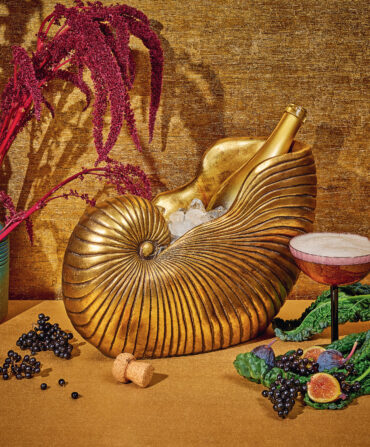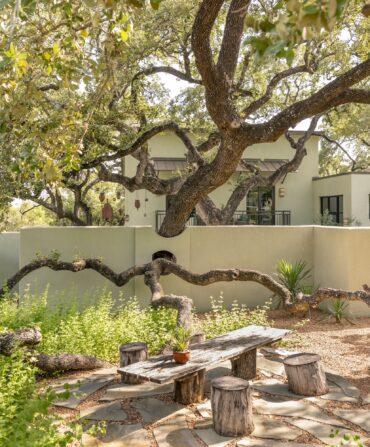Home & Garden
Haven in a Holler: A Couple Transforms a Virginia Farmstead
The mountain property becomes an oasis for entertaining friends and putting down roots
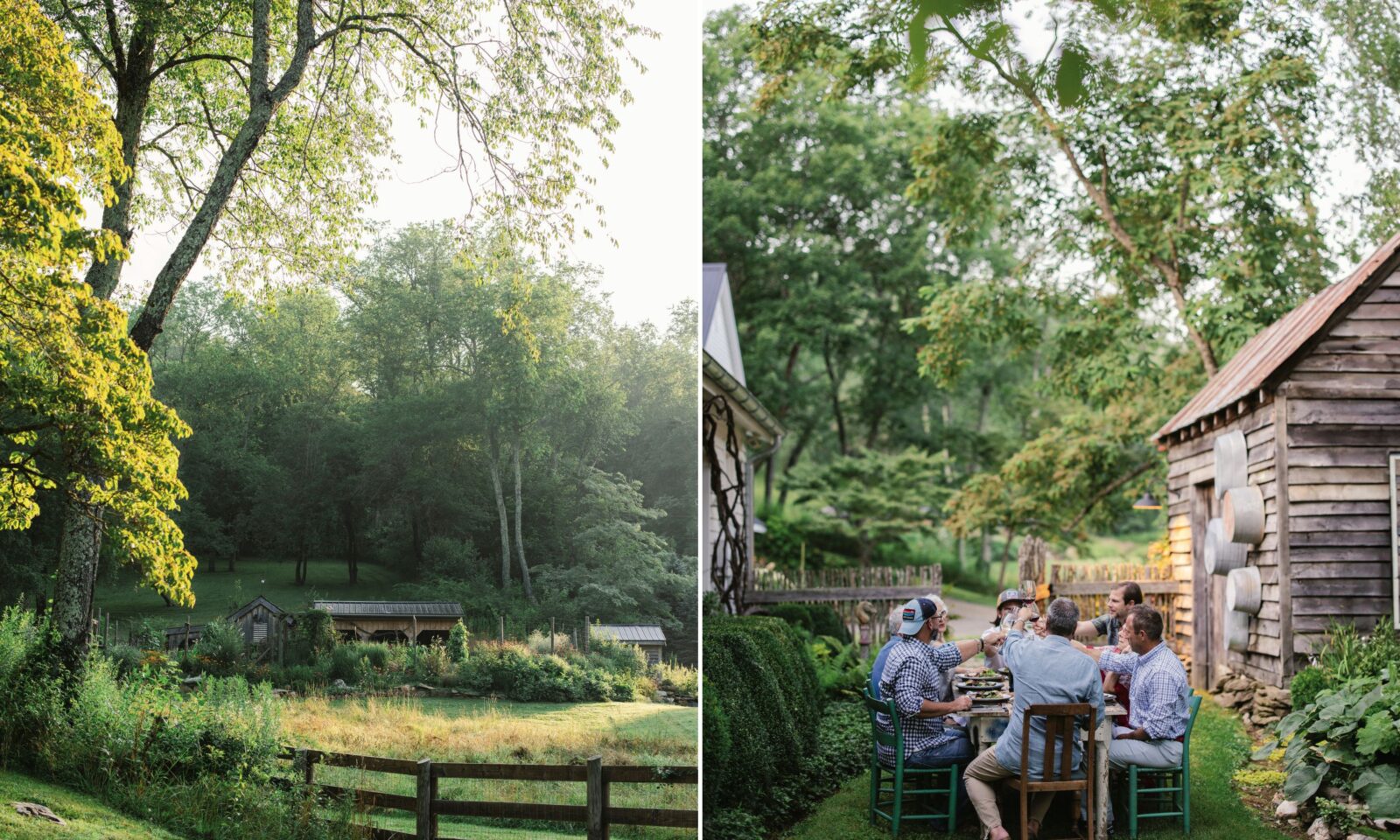
Photo: Patricia Lyons
A sloping view toward the orchard, potting shed, and chicken coop at DrinkWater Farm near Floyd, Virginia; alfresco dinner a few steps away from the garden.
EEEEAAA-ONGK! EEEEAAA-OOONGK! It’s hard to judge if the abrupt braying of mother-and-son donkey duo Little Edie and Diego is truly as loud as it seems, or if the clamor is more a reflection of the prevailing tranquility of DrinkWater Farm.
Regardless, it doesn’t long distract from the spot’s serene spell. Situated not far from the Blue Ridge Parkway, the home of Wade Billeisen and Frank Carochi is reached via ten miles of narrowing rural roads southwest of bluegrass-loving Floyd, Virginia, that lead to a long gravel drive that runs along Burks Fork creek and a copse of trees with firewood stacked neatly between trunks.

Of DrinkWater’s 140 heavily wooded acres below Buffalo Mountain, the couple has spent the last few years carving out (literally, pretty much) a central tract that showcases lushly diverse plantings in degrees of formality, an abundant kitchen garden that achieves comparable flair, and several beguiling outdoor spaces for entertaining frequent guests. “We’re tucked back in a holler, surrounded by forest, so it’s important to create vistas that pull the eye along,” says Billeisen, who has taken on much of the planning and labor required to transform the property from its former life as a fairly staid farmette. “I believe in lots of layering—looking past one thing to another thing, and another thing.”
That visual journey kicks off at the lower driveway with a handsomely unpainted, gambrel-roofed barn inherited from previous owners. The loft now serves as Billeisen’s painting studio (mostly abstract landscapes), while the airy main floor, complete with chandelier, is suited to hosting larger soirees such as community art shows or a fundraiser dinner for the Floyd Initiative for Safe Housing. Integral to the experience are the proximate donkeys, a retired draft horse, and a trio of barn cats named after NPR hosts.
From there, the grounds roll and cant, crowned by a newly dug, spring-fed swimming pond at woods’ edge. (Billeisen was indulging in a late-afternoon dip last summer when a large black bear loped out of the trees. Fortunately, it settled for a quick dunk in the adjacent catch pond before it wandered off.)
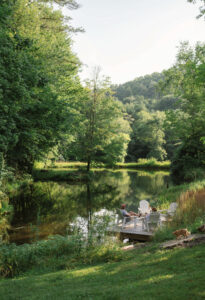
Photo: Patricia Lyons
The dock overlooking a pond is a favorite coffee and cocktail spot.
The couple, together for twenty-three years, has undertaken something of a journey too. Both grew up in Colorado, Carochi on a farm with his Italian family, life experience that imparted the skills to handle DrinkWater’s animals, and a deep appreciation for good food. “Basically, Wade is an obsessive-compulsive German who married a sloppy-cooking Italian,” he says. Sloppy or not, by all accounts that cooking is gourmet, often built around homegrown produce or morels and ramps foraged from the forest.
When Carochi’s career in veterinary lab services took them to Greensboro, North Carolina, in 2007, Billeisen threw himself into renovating a 1917 Germanic Revival cottage there. Next came their first, short stint in Floyd before work called Carochi back to Denver. Billeisen resumed teaching high school art while shouldering another major renovation, of a 1909 Craftsman-esque Denver Square. But small-town Floyd had left its mark, and when the listing for the farm popped up in 2015, they were smitten. “It felt much more like a weekend house at the time, with more farming and cattle,” Carochi says, “but beautiful nonetheless. The property was special.”
They rushed to finish renovating and sell the Denver house. “I was terrified that someone else was going to buy this place before we could get everything together,” Billeisen says. “I told myself, ‘Whatever happens, happens,’ but I kept revisiting the listing.”
After the sale closed, Billeisen kept his teaching post for two more years, so remaking the grounds didn’t begin in earnest until he fully relocated. “Some of our plantings are really maturing for the first time this year,” he says. “It’s exciting, because normally we’ve moved around too much to see that happen.”
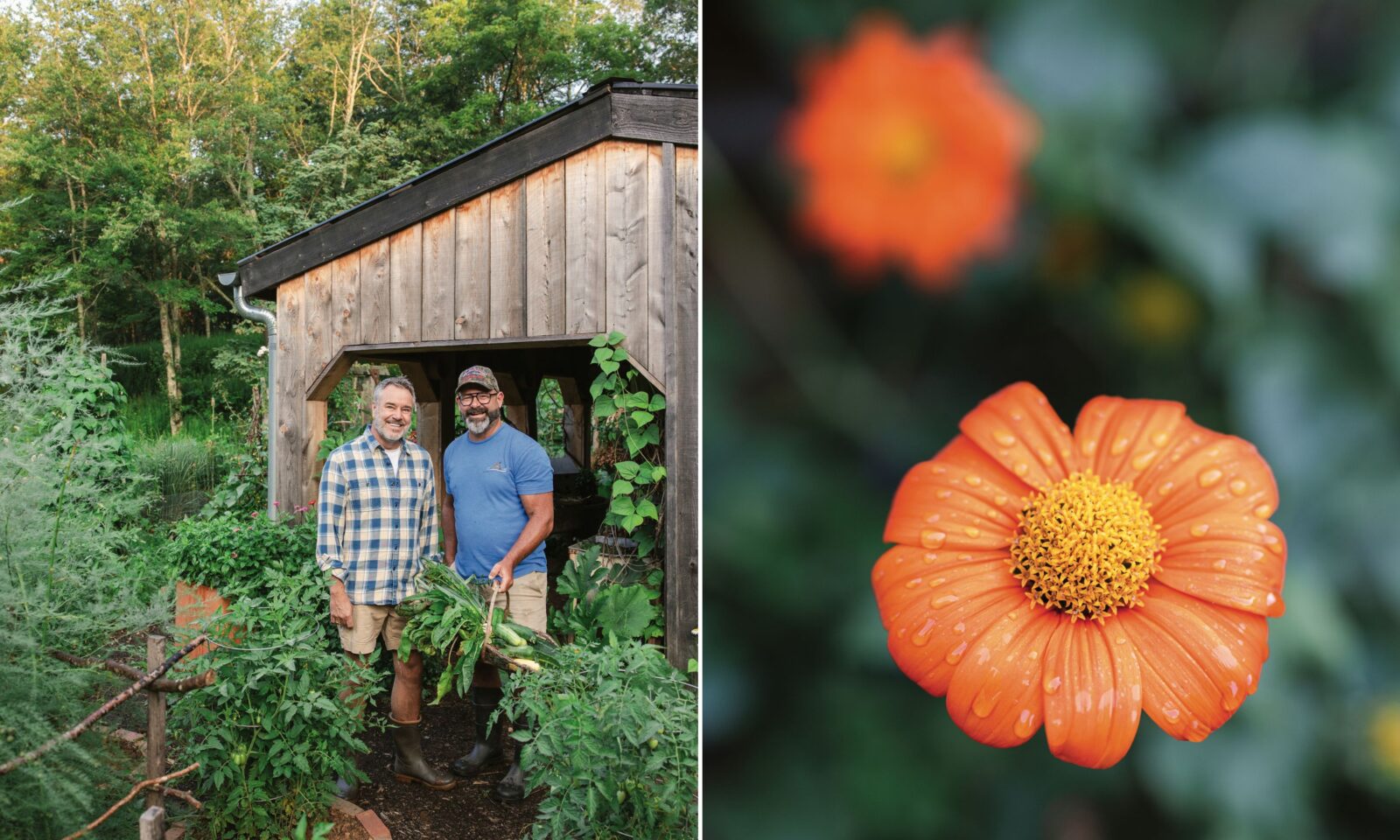
Photo: Patricia Lyons
Frank Carochi and Wade Billeisen in the vegetable garden; orange tithonia.
As early as late February, they first spot the bloom of pussy willows, then daffodils and crocuses, followed by impressionist speckles of dogwoods and serviceberry in the woods. Fieldstone bordered beds near the farmhouse purposely give the most formal impression, planted with hostas, head-high Fire Light hydrangeas that turn white to blush pink, and boxwoods whimsically pruned into the shape of gumdrops. But none of it is too formal, as evidenced by red-orange Major Wheeler honeysuckle creeping up a gate fashioned of branches. Twisted lengths of wild grapevines pulled from the woods frame a shallow front porch that overlooks the nearest of those beds. Lined with rubber boots, the porch also faces a tin-roofed clapboard shed that was relocated from the property’s far reaches to hide a generator. That goal probably could have been accomplished more conventionally, but festooned with vintage washtubs of disparate sizes and shapes, the shed now serves as a rustic focal point.
The farther you roam from the yard toward the woods, the wilder things are allowed to grow, starting with pocket pollinator gardens of drooping purple comfrey and star-shaped blue borage, and onward to mowed swaths bordered by tall grasses and those pussy willows. Wild or not, it all furthers the gaze-pulling scheme. Following one of these paths up to the left reveals a hillside orchard of maybe two dozen apple trees, their spring blossoms scenting a light breeze. (When the fruit ripens, hungry bears don’t seem to mind that they are of uncertain variety.)
Fronting the orchard, a thick wire pen fences off a vegetable patch. The garden surrounds a sturdy potting shed and adjoining chicken coop that yields about six eggs a day from Buff Orpington and Black Copper Maran hens, both structures that Billeisen erected. (“I’m okay building things that humans don’t live in,” he says, laughing.) In spring, those eggs get scrambled for asparagus omelets or poached to complement the garden’s early pickings of frisée. The homeowners especially anticipate the first radishes, sliced thinly on toast with Boursin cheese and chives, or eaten simply with butter and salt. Come late summer, pumpkin vines tumble out from the garden gate, leading to raised beds and teepee trellises fashioned from branches. They go rampant with eggplant, squash, cucumbers, and Italian flat beans grown from seeds Carochi’s father mailed from Colorado.
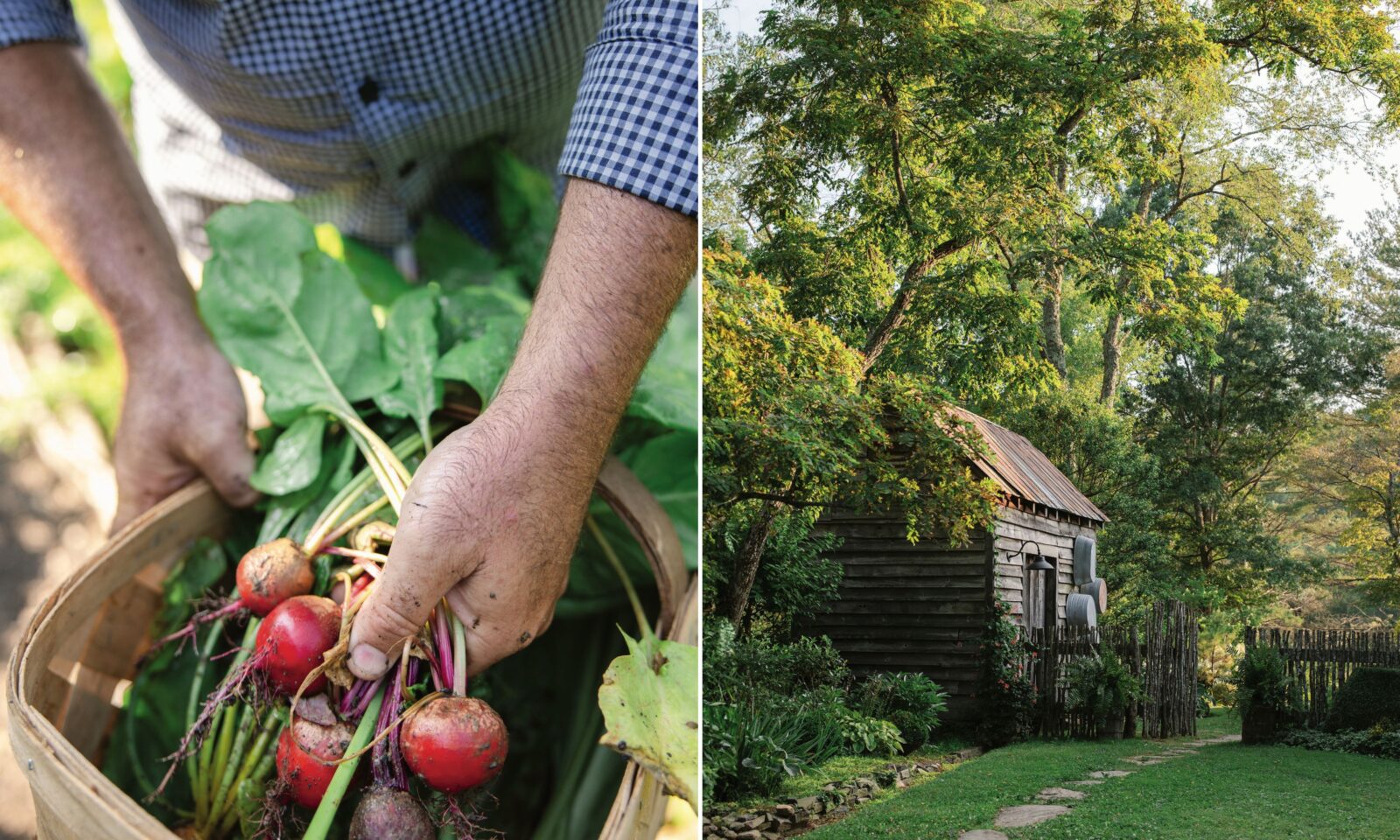
Photo: Patricia Lyons
Just-harvested candy-striped beets; the clapboard shed, adorned with vintage washtubs, and a path through a garden gate.
It’s a verdant, charming space in its own right, but the real showstopper is the subway car–length mound of a flower bed outside the downhill perimeter of the garden fence. Springing thickly from ground cover of creeping Jenny, more than twenty varieties grow in almost as many colors, from instantly recognizable daisies, daffodils, cosmos, and cornflowers to less familiar meadow thistle, clary sage, and Husker Red penstemon. A section of Prairie Glow flowers, a rudbeckia with scarlet petals tipped in brilliant yellow, almost hogs the spotlight. The overall assemblage stems from Billeisen’s desire to mix textures, colors, even leaf sizes—and to go big. “With the scale of this place, I’ve learned that I have to put in sixty plants of anything to make a splash,” he says. Though he owns up to learning as he goes, he credits the internationally renowned Denver Botanic Gardens with inspiring his larger-scale designs. “It was across the park from our house there, and I walked through it daily looking at seasonal plantings and year-round visual interest,” he says. “Another huge inspiration has been the Spikenard Farm Honeybee Sanctuary here in Floyd for planting things specifically for bees and starting our hives.” DrinkWater’s first hive is nicknamed Lexi after a late student of Billeisen’s who helped start a beekeeping club.
The acclaimed Southern garden designer Chip Callaway, who himself owns a weekend house near Floyd, has observed DrinkWater’s progress with fascination. “Wade has been able to interpret Southwest Virginia into his gardens with ease and grace, while also bringing a new aesthetic,” he says. “It’s a bit of an oxymoron, but that aesthetic is highly refined and rustic at the same time. He takes very rustic things and uses them very artistically.”
Despite his decades of experience, Callaway contributed only random ideas, often in the form of reference photos he texted to Billeisen from far-flung locales. “By the time I visit a month later, he’s already done his version of that,” he says. “It’s amazing how he can take some eye candy and make it happen.” Inspiration flows both ways: Callaway recently asked an artist friend to create a large painting representative of DrinkWater’s tree-shaded entrance lane because he finds it so soothing to arrive there.
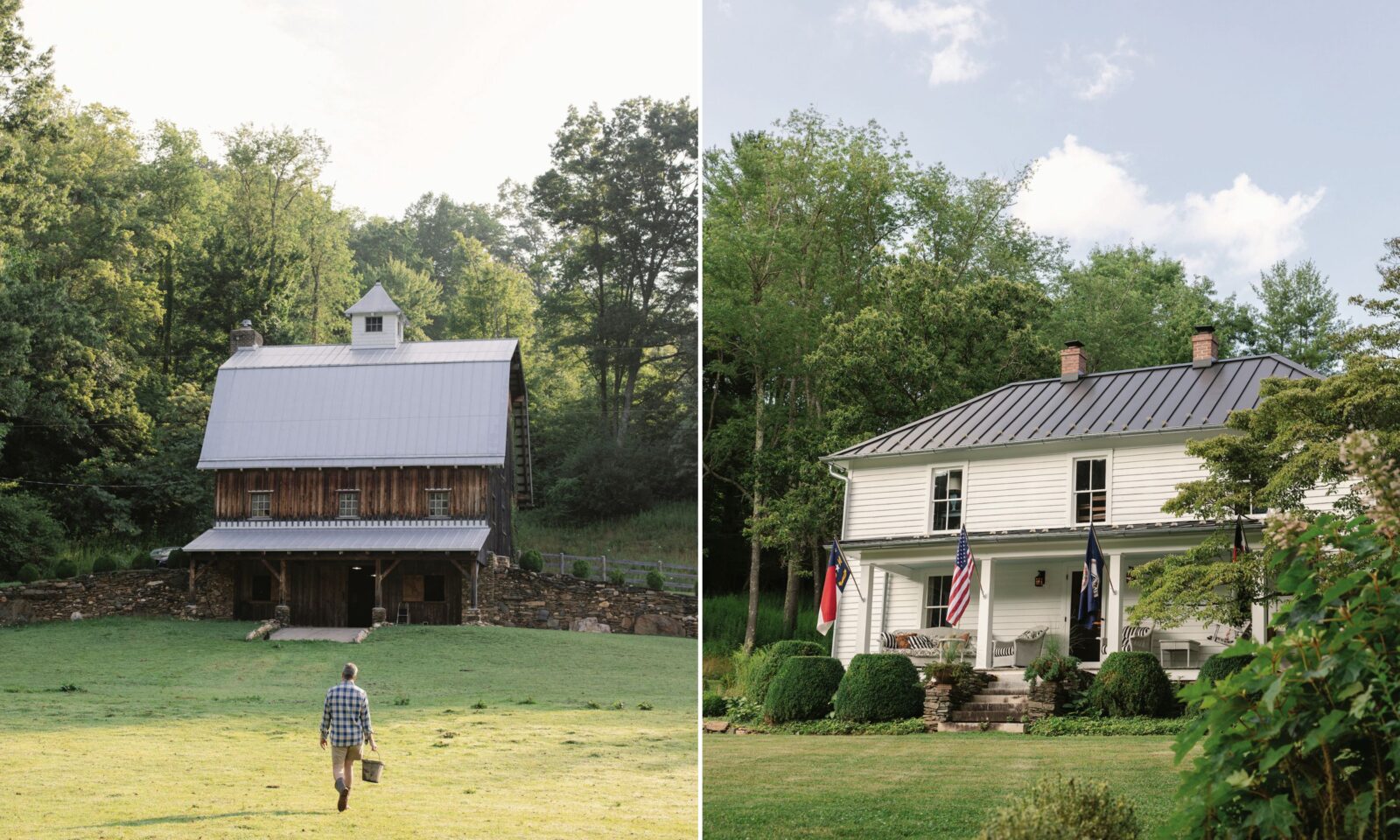
Photo: Patricia Lyons
Carochi walks to the unpainted gambrel-roofed barn; the 1920s farmhouse.
Almost all areas of the property feature outdoor seating arranged for socializing. Indeed, with friends from Chicago, Denver, New York City, California, or Europe visiting almost every weekend from spring through fall, the couple has surrendered the main farmhouse to guests and moved into a new, lodge-like suite constructed atop the old stone garage. Hopefully, guests appreciate the sacrifice. The classic white farmhouse, built in the 1920s and expanded fifteen years ago, is warmly and gorgeously filled with eclectic furnishings and decor—leather sofa, steamer trunk coffee table, saucers bearing the image of Queen Elizabeth—mostly procured from the Floyd gas station turned antique store Finders Keepers. An exception worthy of digression: the large butcher-block kitchen island, purchased from a Toronto family bakery upon its closure. In addition to scraping off a half inch of doughnut residue, Billeisen and Carochi had to promise the retiring baker they would make a toast to good health around the table each holiday season using a set of crystal aperitif glasses that came with the sale.
Most entertaining tends to take place across from the garage, in the “pizza barn.” (Intrigued already, aren’t you?) From the front, the structure, built by David and Jack Morris of Floyd’s Upon the Earth Construction, seems to be a fetchingly utilitarian five-bay woodshed of locally milled pine and hemlock. Except that the fifth bay is actually a doorway that leads into a carport-proportioned party wonderland. The back side, absent a wall, overlooks the burbling creek and features a ski lodge–like seating area centered on a freestanding conical fireplace in cheerful red enamel. To one side sits Carochi’s grandfather’s dinged-up horse trailer, which they drove from Colorado and converted into a well-stocked three-stool bar. An early 1950s Ford truck in shades of black, white, and rust dominates the rest of the space. On its flatbed perches the item that earns this hideaway its nickname—a wood-burning pizza oven.
It is here that they host frequent pizza nights, for which they supply booze and dough and guests show up with their own toppings. “The community here is amazing,” Billeisen says. “Floyd has a really interesting mix of people, and we can pull together a twelve-person dinner party in no time.”
Carochi picks up the thought: “It’s a cool bubble here. Growing up, I wanted to get out of a small town that was a little closed-minded. But that’s where I learned how to garden and can, and now things have come full circle. I’m from the mountains in Colorado, and this has a bit of that feel. At the end of the day, there’s something that makes me feel at peace here.”
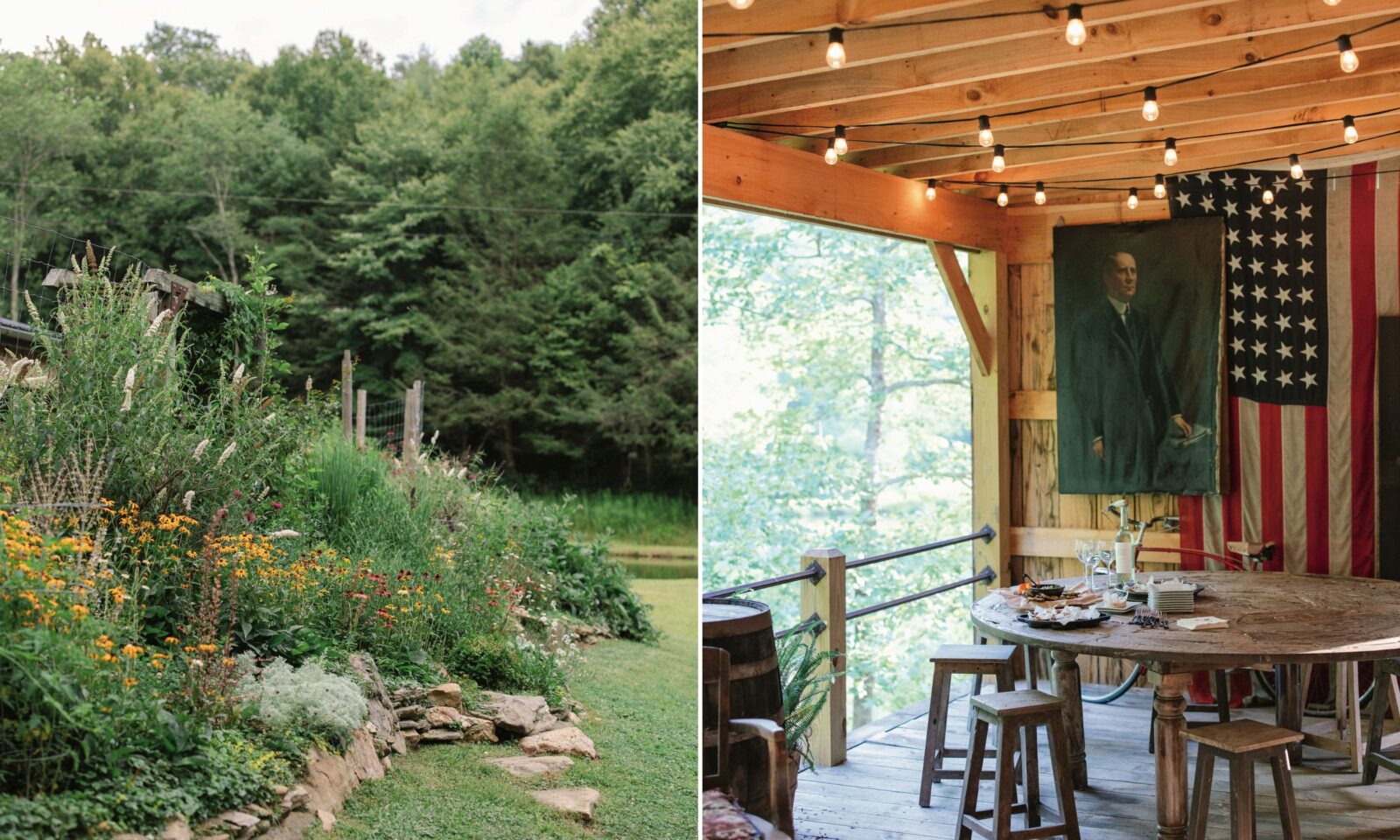
Photo: Patricia Lyons
A pocket of pollinator plants, lined with fieldstone from the property; welcoming seats and an antique forty-eight-star American flag inside the "pizza barn."
While nibbling a prosciutto-and-fig slice or mixing a fresh cocktail, one might notice that the pizza barn continues a curious decorating motif. When Billeisen came across eleven unframed oil portraits of past leaders of the Independent Order of Odd Fellows dating back to 1872 in a Winston-Salem, North Carolina, antique store, he felt compelled to rescue them. These rather stern old gents now gaze out from a wall here, the farmhouse mantel and bedrooms, even the potting shed. Never really a focal point, they are nonetheless a hoot to count as one explores the property.
“Wade looks at hanging out as an experience, and he wants people to have an experience that’s memorable,” Carochi says. “It doesn’t have to be luxurious, just memorable. I don’t have a creative mind, but he’s always had a talent for this sort of thing. He uses his visual skills, and we do the food, and everything provides connective tissue for a full story.” (A little later, with Carochi out of earshot, Billeisen dismisses the assertion that his husband doesn’t bring creativity to the effort, insisting that many of DrinkWater’s attributes result from his ideas. Indeed, it was his notion to dub the farm DrinkWater, cribbed from the name of a boulevard in Scottsdale, Arizona, he’d mentally filed away years earlier.)
The couple’s combined efforts and talents have made DrinkWater a truly welcoming and bucolic spot. Given their past as serial renovators, though, one wonders if they might move on again.
“This one is permanent,” Billeisen says. “I’m the happiest I’ve ever been.”
“We feel good here,” Carochi concurs.
That’s not to say they’re quite finished working on the place. Plans for this spring alone include cleaning up the apple orchard, working compost into garden beds, harvesting honey, and adding a wraparound porch to the farmhouse. “Oh, I’ve got projects planned out for a while,” Billeisen says with a laugh. “I’ll never be finished.”


